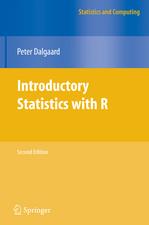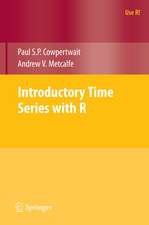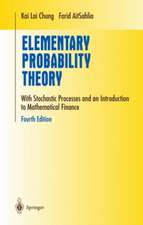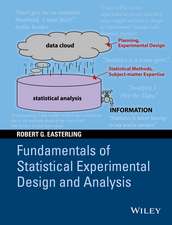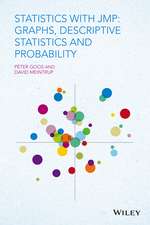Smoothing Spline ANOVA Models: Springer Series in Statistics, cartea 297
Autor Chong Guen Limba Engleză Paperback – 25 iun 2015
known as smoothing, has been studied by several generations of
statisticians. Assisted by the ample computing power in today's
servers, desktops, and laptops, smoothing methods have been finding
their ways into everyday data analysis by practitioners. While scores
of methods have proved successful for univariate smoothing, ones
practical in multivariate settings number far less. Smoothing spline
ANOVA models are a versatile family of smoothing methods derived
through roughness penalties, that are suitable for both univariate and
multivariate problems.
In this book, the author presents a treatise on penalty smoothing
under a unified framework. Methods are developed for (i) regression
with Gaussian and non-Gaussian responses as well as with censored lifetime data; (ii) density and conditional density estimation under a
variety of sampling schemes; and (iii) hazard rate estimation with
censored life time data and covariates. The unifying themes are the
general penalized likelihood method and the construction of
multivariate models with built-in ANOVA decompositions. Extensive
discussions are devoted to model construction, smoothing parameter
selection, computation, and asymptotic convergence.
Most of the computational and data analytical tools discussed in the
book are implemented in R, an open-source platform for statistical
computing and graphics. Suites of functions are embodied in the R
package gss, and are illustrated throughout the book using simulated
and real data examples.
This monograph will be useful as a reference work for researchers in
theoretical and applied statistics as well as for those in other
related disciplines. It can also be used as a text for graduate level
courses on the subject. Most of the materials are accessibleto a
second year graduate student with a good training in calculus and
linear algebra and working knowledge in basic statistical inferences
such as linear models and maximum likelihood estimates.
| Toate formatele și edițiile | Preț | Express |
|---|---|---|
| Paperback (1) | 951.77 lei 6-8 săpt. | |
| Springer – 25 iun 2015 | 951.77 lei 6-8 săpt. | |
| Hardback (1) | 956.03 lei 6-8 săpt. | |
| Springer – 25 ian 2013 | 956.03 lei 6-8 săpt. |
Din seria Springer Series in Statistics
- 14%
 Preț: 679.60 lei
Preț: 679.60 lei - 20%
 Preț: 630.97 lei
Preț: 630.97 lei - 20%
 Preț: 816.43 lei
Preț: 816.43 lei - 20%
 Preț: 1000.84 lei
Preț: 1000.84 lei -
 Preț: 390.84 lei
Preț: 390.84 lei - 20%
 Preț: 697.13 lei
Preț: 697.13 lei - 20%
 Preț: 445.20 lei
Preț: 445.20 lei - 20%
 Preț: 881.51 lei
Preț: 881.51 lei - 18%
 Preț: 1237.14 lei
Preț: 1237.14 lei - 18%
 Preț: 967.22 lei
Preț: 967.22 lei - 18%
 Preț: 956.50 lei
Preț: 956.50 lei - 18%
 Preț: 794.25 lei
Preț: 794.25 lei - 15%
 Preț: 648.05 lei
Preț: 648.05 lei - 18%
 Preț: 1222.49 lei
Preț: 1222.49 lei - 15%
 Preț: 646.11 lei
Preț: 646.11 lei - 15%
 Preț: 647.08 lei
Preț: 647.08 lei - 15%
 Preț: 646.11 lei
Preț: 646.11 lei - 18%
 Preț: 1389.62 lei
Preț: 1389.62 lei - 15%
 Preț: 652.81 lei
Preț: 652.81 lei - 18%
 Preț: 1114.52 lei
Preț: 1114.52 lei - 18%
 Preț: 952.40 lei
Preț: 952.40 lei - 18%
 Preț: 1393.27 lei
Preț: 1393.27 lei - 18%
 Preț: 1561.68 lei
Preț: 1561.68 lei - 18%
 Preț: 1231.47 lei
Preț: 1231.47 lei - 15%
 Preț: 513.64 lei
Preț: 513.64 lei - 18%
 Preț: 893.71 lei
Preț: 893.71 lei - 15%
 Preț: 649.87 lei
Preț: 649.87 lei - 18%
 Preț: 1007.65 lei
Preț: 1007.65 lei - 18%
 Preț: 1111.67 lei
Preț: 1111.67 lei - 18%
 Preț: 1229.10 lei
Preț: 1229.10 lei - 18%
 Preț: 892.74 lei
Preț: 892.74 lei - 18%
 Preț: 913.26 lei
Preț: 913.26 lei - 18%
 Preț: 943.88 lei
Preț: 943.88 lei -
 Preț: 391.61 lei
Preț: 391.61 lei -
 Preț: 391.22 lei
Preț: 391.22 lei - 18%
 Preț: 1391.04 lei
Preț: 1391.04 lei -
 Preț: 390.84 lei
Preț: 390.84 lei - 18%
 Preț: 893.84 lei
Preț: 893.84 lei - 18%
 Preț: 960.61 lei
Preț: 960.61 lei - 18%
 Preț: 1245.34 lei
Preț: 1245.34 lei - 18%
 Preț: 964.54 lei
Preț: 964.54 lei - 15%
 Preț: 643.16 lei
Preț: 643.16 lei - 18%
 Preț: 1674.70 lei
Preț: 1674.70 lei - 15%
 Preț: 643.84 lei
Preț: 643.84 lei - 15%
 Preț: 586.37 lei
Preț: 586.37 lei - 18%
 Preț: 1004.99 lei
Preț: 1004.99 lei - 15%
 Preț: 643.34 lei
Preț: 643.34 lei - 18%
 Preț: 806.40 lei
Preț: 806.40 lei - 18%
 Preț: 727.66 lei
Preț: 727.66 lei
Preț: 951.77 lei
Preț vechi: 1160.70 lei
-18% Nou
Puncte Express: 1428
Preț estimativ în valută:
182.15€ • 188.17$ • 151.59£
182.15€ • 188.17$ • 151.59£
Carte tipărită la comandă
Livrare economică 26 martie-09 aprilie
Preluare comenzi: 021 569.72.76
Specificații
ISBN-13: 9781489989840
ISBN-10: 1489989846
Pagini: 452
Ilustrații: XVIII, 433 p.
Dimensiuni: 155 x 235 x 27 mm
Greutate: 0.63 kg
Ediția:2nd ed. 2013
Editura: Springer
Colecția Springer
Seria Springer Series in Statistics
Locul publicării:New York, NY, United States
ISBN-10: 1489989846
Pagini: 452
Ilustrații: XVIII, 433 p.
Dimensiuni: 155 x 235 x 27 mm
Greutate: 0.63 kg
Ediția:2nd ed. 2013
Editura: Springer
Colecția Springer
Seria Springer Series in Statistics
Locul publicării:New York, NY, United States
Public țintă
ResearchCuprins
Introduction.- Model Construction.- Regression with Gaussian-Type Responses.- More Splines.- Regression and Exponential Families.- Regression with Correlated Responses.- Probability Density Estimation.- Hazard Rate Estimation.- Asymptotic Convergence.- Penalized Pseudo Likelihood.
Recenzii
“The purpose of the book is to comprehensivelypresent smoothing and penalized splines from the point of view of reproducingkernel Hilbert spaces (RKHS). … the book makes a valuable contribution to theliterature on smoothing and penalized splines, especially for moremathematically oriented researchers.” (W. John Braun, Technometrics, Vol. 56 (4), November,2014)
Notă biografică
Chong Gu received his Ph.D. from University of Wisconsin-Madison in 1989, and has been on the faculty in Department of Statistics, Purdue University since 1990. At various times during his career, he has held visiting appointments at University of British Columbia, University of Michigan, and National Institute of Statistical Sciences.
Textul de pe ultima copertă
Nonparametric function estimation with stochastic data, otherwise
known as smoothing, has been studied by several generations of
statisticians. Assisted by the ample computing power in today's
servers, desktops, and laptops, smoothing methods have been finding
their ways into everyday data analysis by practitioners. While scores
of methods have proved successful for univariate smoothing, ones
practical in multivariate settings number far less. Smoothing spline
ANOVA models are a versatile family of smoothing methods derived
through roughness penalties, that are suitable for both univariate and
multivariate problems.
In this book, the author presents a treatise on penalty smoothing
under a unified framework. Methods are developed for (i) regression
with Gaussian and non-Gaussian responses as well as with censored lifetime data; (ii) density and conditional density estimation under a
variety of sampling schemes; and (iii) hazard rate estimation with
censored life time data and covariates. The unifying themes are the
general penalized likelihood method and the construction of
multivariate models with built-in ANOVA decompositions. Extensive
discussions are devoted to model construction, smoothing parameter
selection, computation, and asymptotic convergence.
known as smoothing, has been studied by several generations of
statisticians. Assisted by the ample computing power in today's
servers, desktops, and laptops, smoothing methods have been finding
their ways into everyday data analysis by practitioners. While scores
of methods have proved successful for univariate smoothing, ones
practical in multivariate settings number far less. Smoothing spline
ANOVA models are a versatile family of smoothing methods derived
through roughness penalties, that are suitable for both univariate and
multivariate problems.
In this book, the author presents a treatise on penalty smoothing
under a unified framework. Methods are developed for (i) regression
with Gaussian and non-Gaussian responses as well as with censored lifetime data; (ii) density and conditional density estimation under a
variety of sampling schemes; and (iii) hazard rate estimation with
censored life time data and covariates. The unifying themes are the
general penalized likelihood method and the construction of
multivariate models with built-in ANOVA decompositions. Extensive
discussions are devoted to model construction, smoothing parameter
selection, computation, and asymptotic convergence.
Caracteristici
Covers latest research of smoothing methods in data analysis Second edition is updated with latest computational methods, including the uses ofthe R package gss Empirical studies are expanded, reorganized, and mostly rerun using the latest software Two new appendices are also added, outlining the overall design of the R package gss and coverage of new and controversial topics on smoothing methods Includes supplementary material: sn.pub/extras



